Manchester United come into the season off the back of their most successful season since 2016/17. In Erik Ten Hag’s debut season, he brought back silverware to Old Trafford with a Carabao Cup victory over Newcastle while helping the Red Devils rise to third in the league and reach the FA Cup final against Manchester City.
Hope is on the horizon, with a return to Champions League football and a bunch of confirmed and potential arrivals about to transform United into a side ready to battle on all fronts.
In Ten Hag’s first couple of fixtures, his side’s attempted to bravely build play from the back and retain possession of the ball. The sudden culture change was hard to adjust to, with catastrophic mistakes in the build-up causing the Red Devils to fall to back-to-back humiliating defeats.
Erik ten Hag quickly reacted to his players’ best strengths. It altered the system to reduce the ball playing load on specific players and simultaneously increase the rate of counterattacks by sitting deeper and encouraging teams to attack them in certain games.
Manchester United have struggled to be efficient in front of goal under Ten Hag’s leadership so far, with only 53 goals scored by United players from 61.33 xG created in the Premier League. This underperformance of xG emphasises the need for a striker to be signed in the summer, with Marcus Rashford having been required to fill the role in the absence of a centre-forward following Cristiano Ronaldo’s departure.
In this tactical analysis, Manchester United’s tactics will be thoroughly inspected to understand how Erik Ten Hag has helped them become one of the best teams in the Premier League again, and how they could potentially adjust their style for next season. Furthermore, we will conduct an analysis of their principles in and out of possession, as well as a brief scout report on the key players and how certain individuals could potentially help United reach a level they haven’t seen in the last decade.
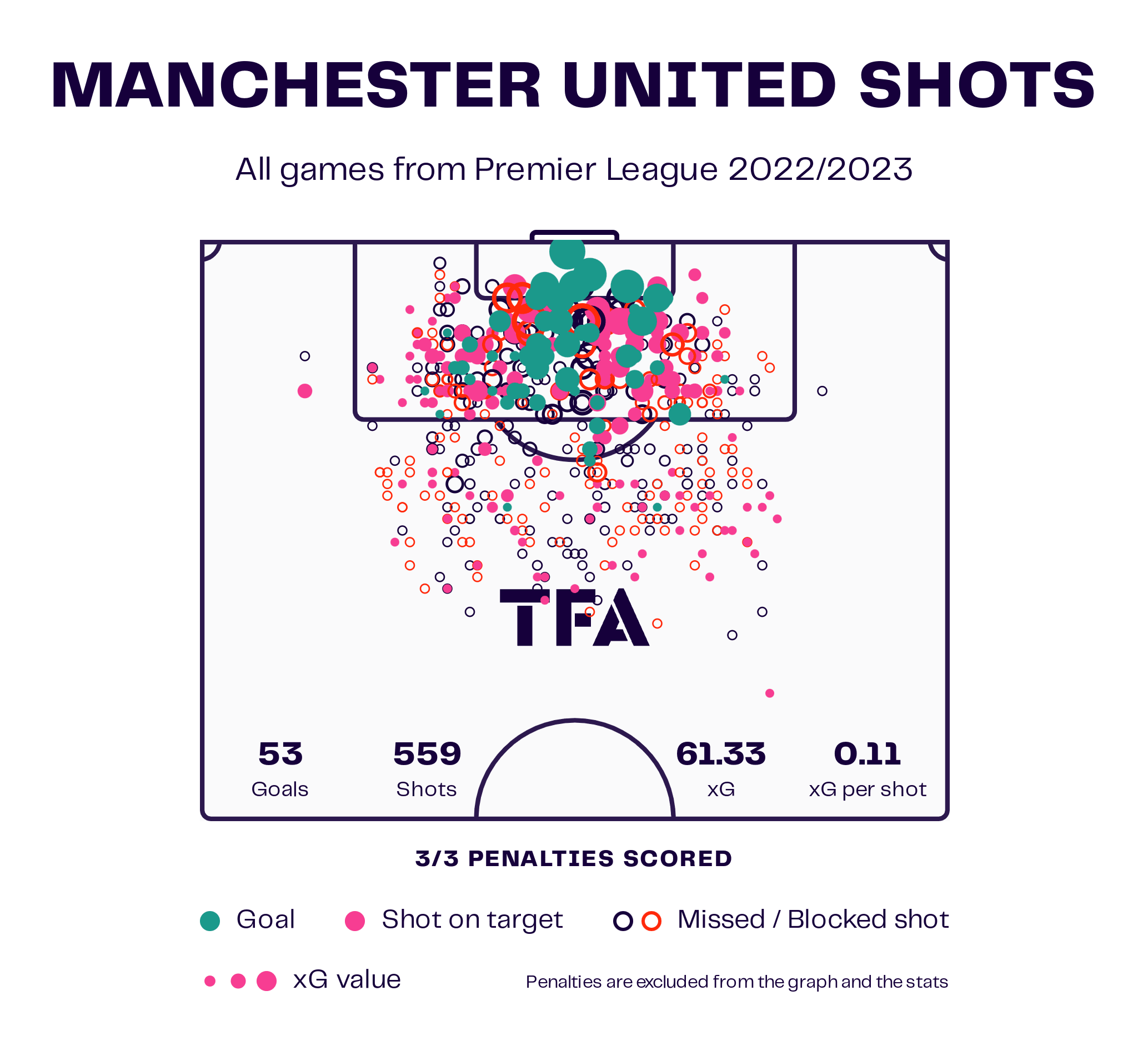
Defensively, they have conceded less than expected, which can be down to a number of different reasons. Their deep blocks at times have meant that although they face a large number of shots in some games, none of the shots are likely to go in.
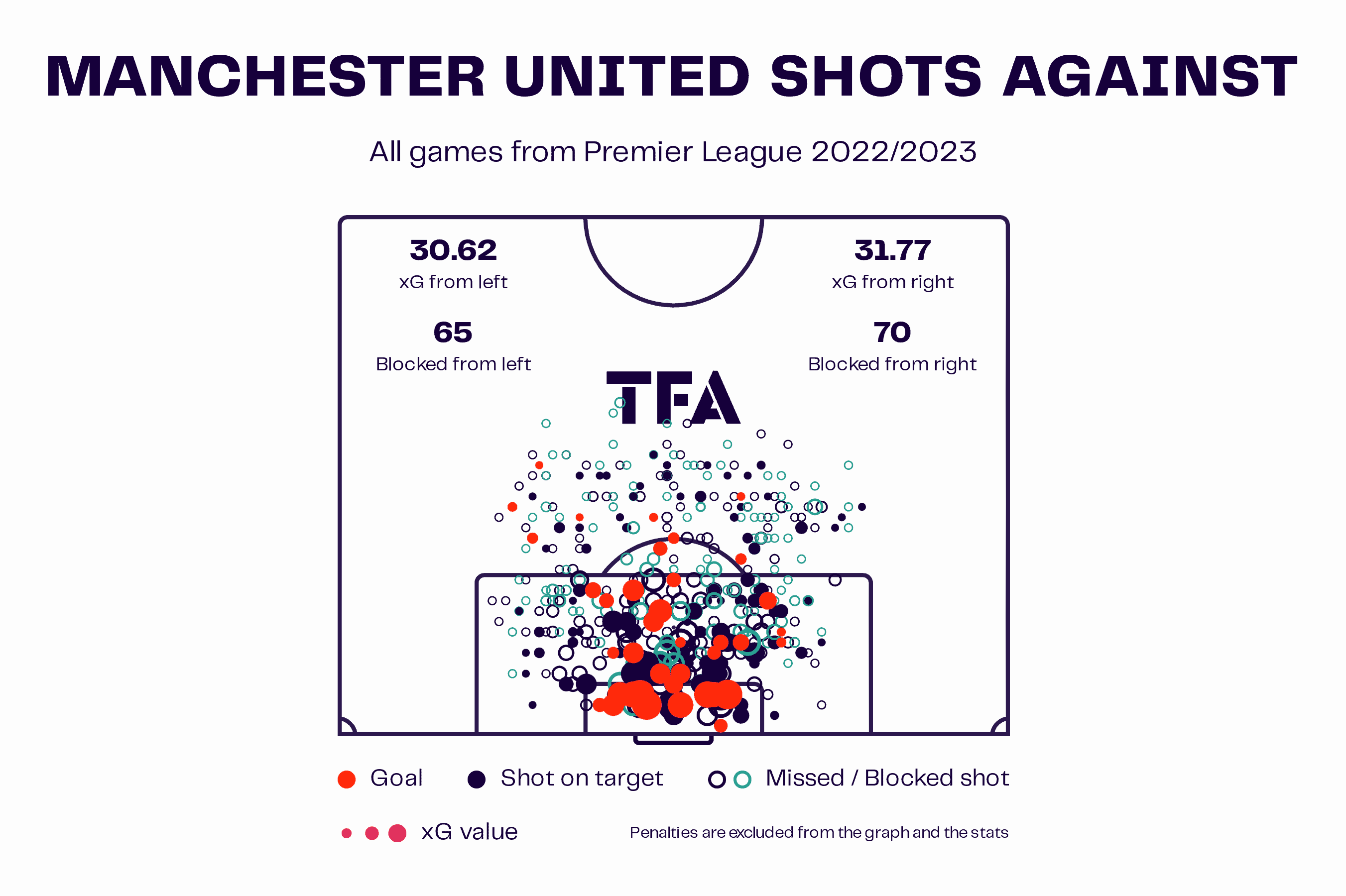
The squad age profile image below shows the large majority of the United squad being in the peak of their career. Their strongest XI, will almost all be in their peak for this coming season, apart from the experienced Casemiro and youthful potential wide options, and newcomer Rasmus Hojlund. A starting side in the peak of their careers, under a coach in his second year in charge will mean that Manchester United will be in perfect conditions to perform at the peak of their abilities, whatever level that may be at.
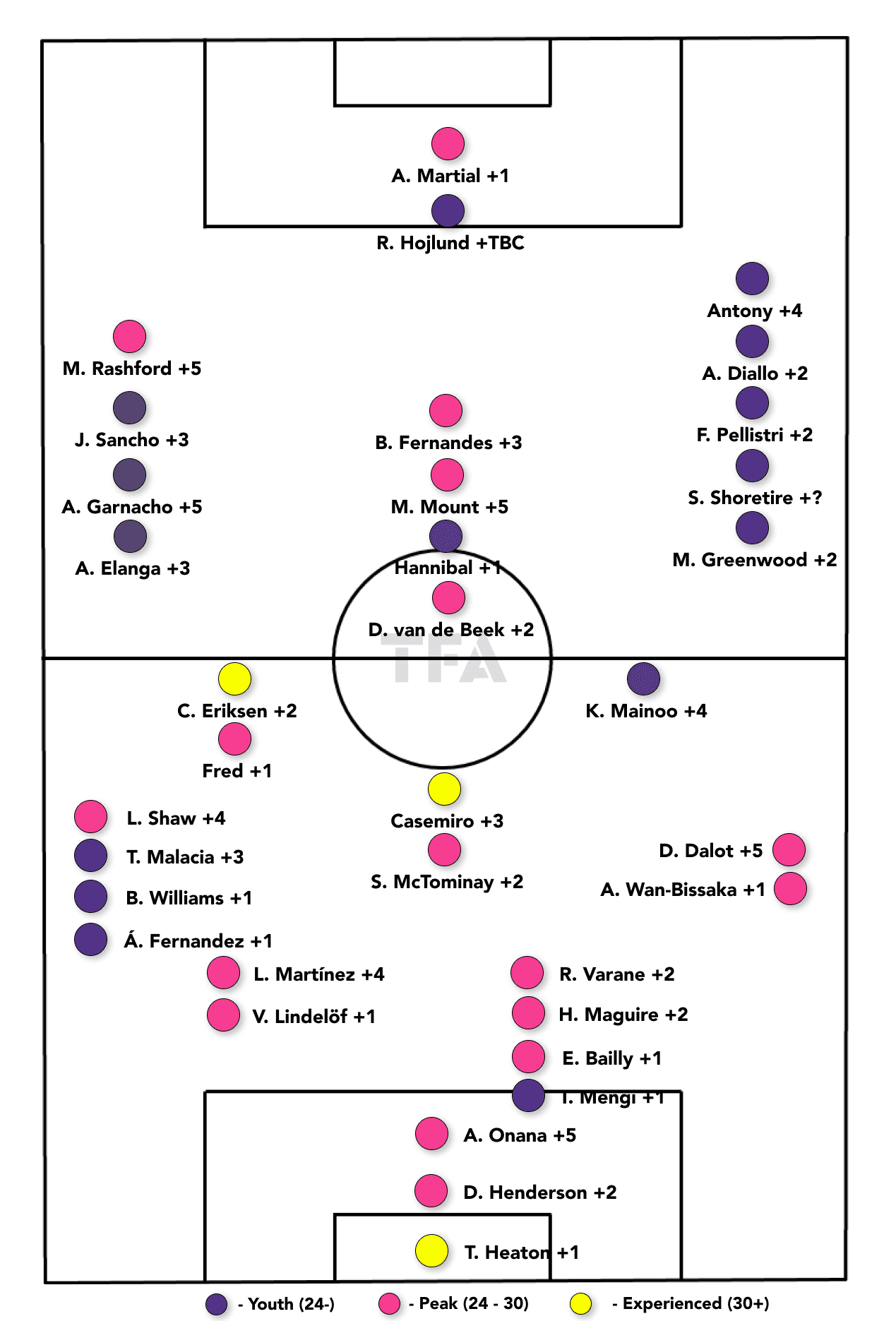
At the time of writing, Manchester United have already made big statements in the transfer window, signing Mason Mount from Chelsea and André Onana from Inter Milan. After replacing David de Gea, Man United will attempt to build upon their defensive statistics through Onana’s excellent shot-prevention abilities in claiming crosses and through balls. Onana will also help his side improve their ability to build play out from the back and progress the ball through passing patterns.
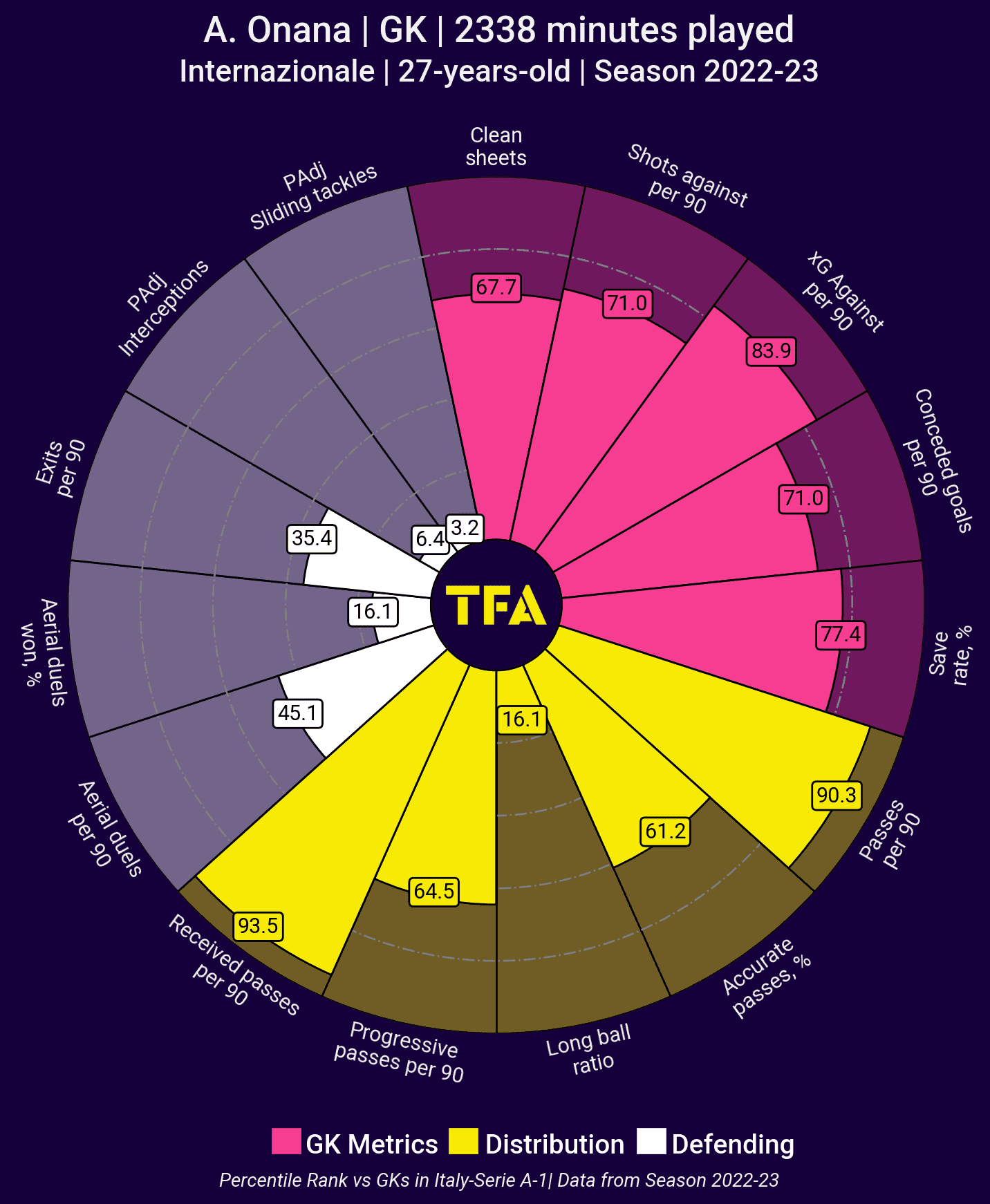
In the past few days, the transfer for Atalanta’s strong and mobile striker, Rasmus Hojlund has been all but confirmed with a price agreed and the player’s desire being to move to the red side of Manchester. A presence like Hojlund up front will allow United to have a greater variety of ways to attack and increase their attacking potential in both counterattacks and settled play. His ability to hold up play, link up with other attackers both in tight spaces and over larger distances, and attack space with his pace and power will add an element of inevitability to Manchester United. When United attack, they will be dangerous, no matter whether it’s against a low block, high press or in transition.
The days are over of relying on a transition goal with Bruno Fernandes and Marcus Rashford, or a crossing opportunity from Luke Shaw. These will still be key ways of scoring for United, but with further possibilities to score, their attacks will become unpredictable, and teams won’t be able to stifle United through dropping deep and removing their only real threatening quality – speed.
In the build up, Onana will have the option of launching a long ball into the forward if under too much pressure, with Hojlund’s ability to hold the ball up, and then turn and attack the space left behind allowing Manchester United to turn build up into a transition attack within a matter of seconds. Their threat in these situations will aid United’s build up aswell, by making opposition teams more hesitant when pressing, giving each defensive player more time.
Although big money has been spent, Manchester United still need a midfielder capable of partnering Casemiro in the midfield pivot. Mount is expected to do the job, but there are concerns about his ability to help a team dominate the ball in the build-up due to his attacking nature of always looking to play the pass forward.
Manchester United should look to improve the quality of their midfield to help mask Casemiro’s weaknesses in the build-up by signing a technically excellent player who can play under pressure whilst also being able to dictate the tempo of the game.
Attacking Phase
While Manchester United possesses many goal threats in the likes of Fernandes and Rashford, their goalscoring numbers were on the low end in Ten Hag’s debut season. With 58 goals in 38 league games, only Aston Villa and Fulham scored fewer goals than them out of all top-half Premier League teams. Part of the issue came from their more pragmatic style without the ball, although problems on the ball also arose due to their dysfunctional attacking unit.
The most significant difference we can expect in Manchester United from the first to the second season will be in their ability and frequency of progressing the ball from the goalkeeper. At the time of writing, André Onana has not appeared for his new side, but his ball-playing ability is undeniably excellent and will completely change how United build play.
We have already seen a sneak peek of United’s build-up efforts in pre-season, which will indeed be continued and developed throughout the season. We can see United already attempting to use the goalkeeper to progress the ball and a clear 3-2 structure in the 1st phase.
The image below highlights the structure while the players are in slightly different places from where they would usually be; this emphasises the fluidity in the build-up patterns that can be achieved with clear principles.
Two players drop on either side of the goalkeeper to provide United with the width in their build-up, while two players offer a forward passing option, forming triangles in wide areas for progression.
In this example below, Lisandro Martínez displays United’s fluidity in the build-up by taking the position of a holding midfielder, moving from centre back, where he can maintain a more central position, due to his comfort on the ball and under pressure.
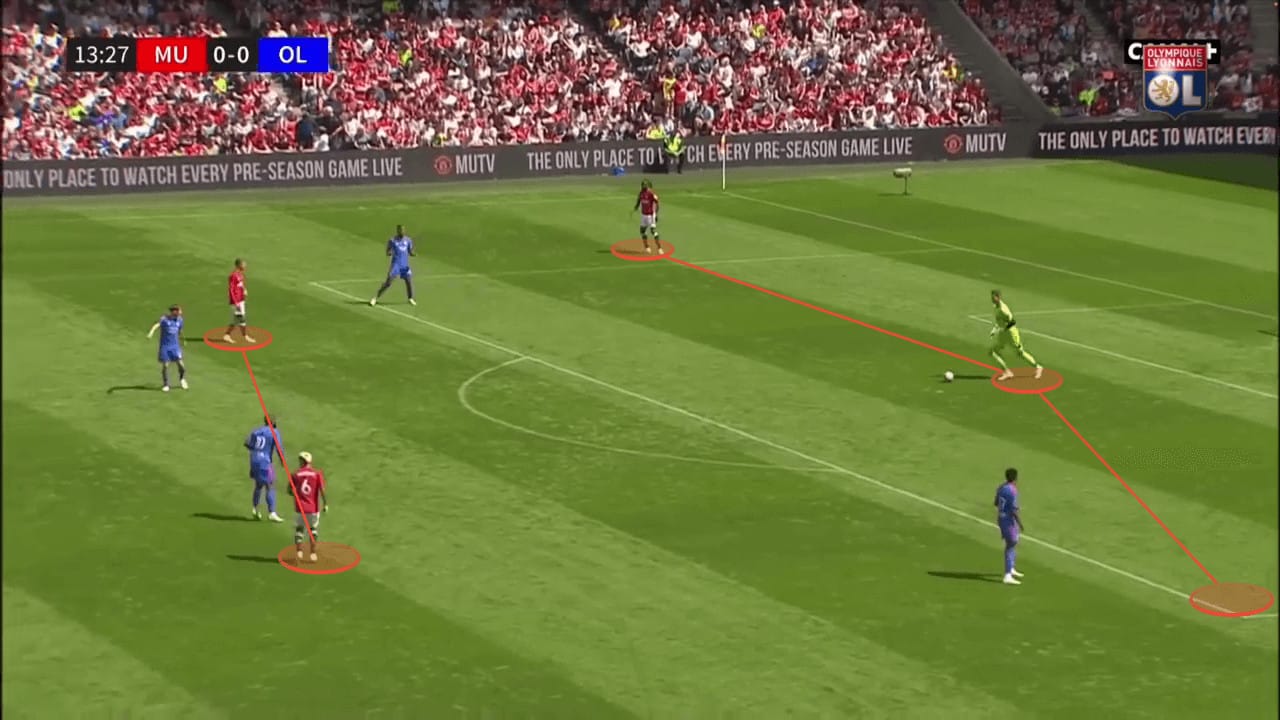
Having these clear structures in places allows Man United to quickly move into their preferred shapes, even if players are caught up in different positions from where they should be after changes in possession.
The wide positioning of the two pivot players allows United to have the potential to progress play in wider areas after combining with wide centre-backs and then having the possibility to find players further up the pitch as the pivot pairing opens up passing lanes to the striker and both wide players.
Players in pockets between the opposition midfield and defence can also drift to find spaces between the lines, with the back four usually pinned back by United’s front three.
When the more direct option is used to a player in the forward line, the two pivot players can then drive up the pitch to become the receivers, using third-man runs.
The example below shows a more direct pass being played, this time to the ‘10’, where he can receive the ball and bypass the original opposition press before laying it off to the third-man runners in either Mount or Martínez.
The opposition players can be seen cutting off the passing lanes to the original positioning of the double-pivot. Still, the quick passing and constant movement allow the pair to drive into higher positions untracked and able to carry the ball up the pitch, with the front three all aiding the attack.
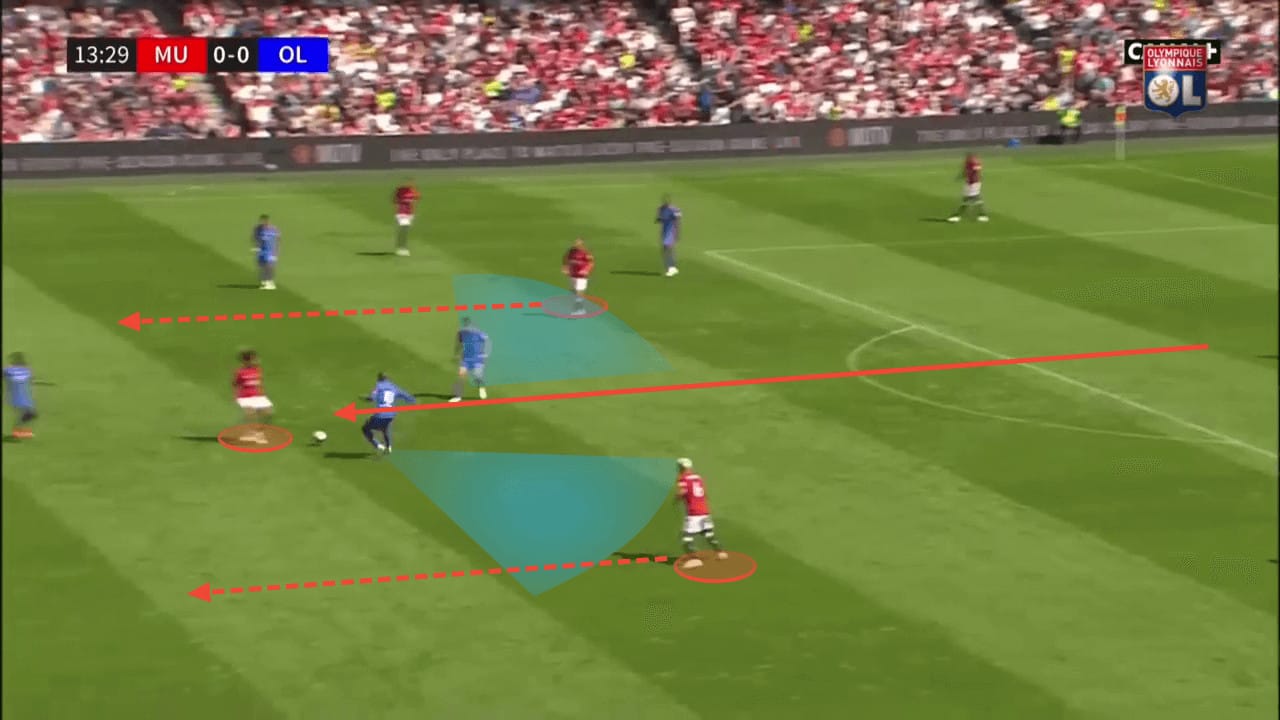
While Manchester United haven’t yet used their new signings together, it is clear that they will favour a shorter passing approach from the back. This approach will help to make the most out of the qualities in United’s defensive unit, with Martínez, Onana, and Shaw particularly excelling due to their technical quality on the ball.
The image below again displays United’s 3-2 structure and captures Martínez’s ability to play under pressure. After receiving the ball from the goalkeeper, he is aware and agile enough to turn into the free space made through Man United’s shape.
Other opposition defenders are pinned to their positions due to Ten Hag’s system, which utilises maximum width and depth, allowing Martínez to carry the ball toward the halfway line.
The brave and aggressive movements of the central defenders, Martínez in particular, will be essential to United’s ability to progress the ball, and United have the versatility, thanks to Onana, to spray the ball to an open forward should the opposition press aggressively and cover the central options.
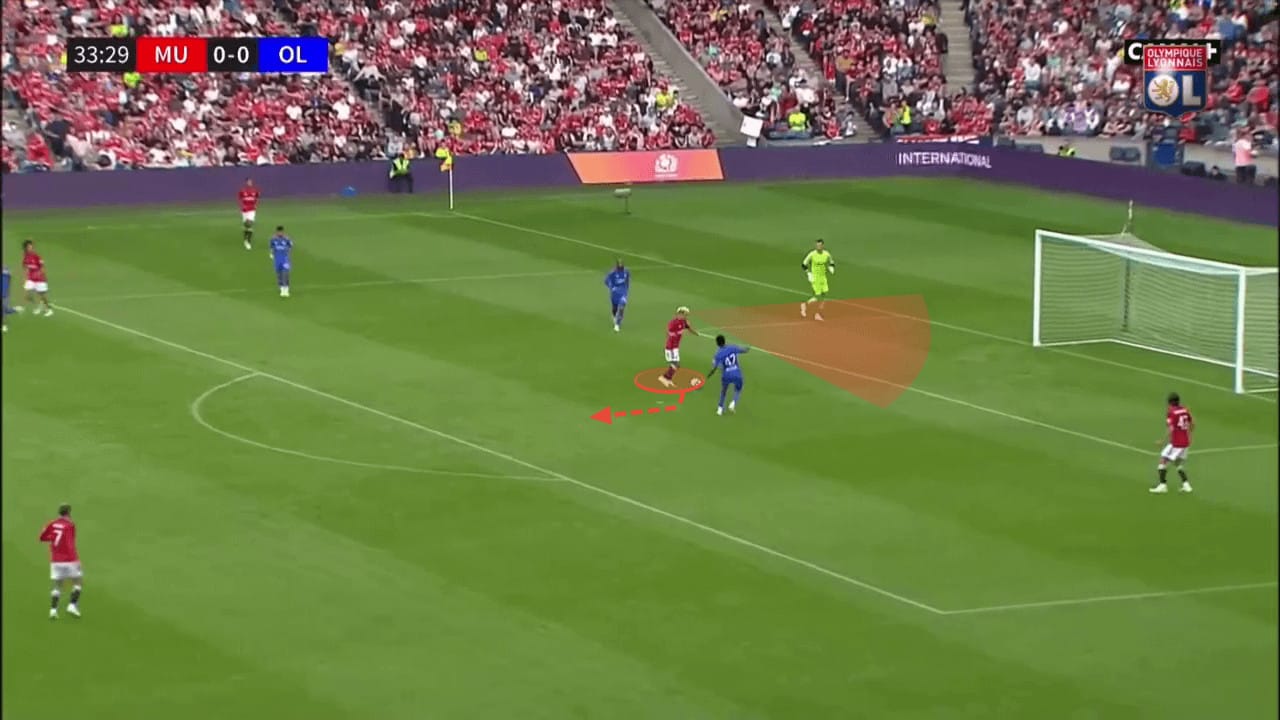
Manchester United will be highly comfortable and patient in their half. However, the profiles of their attacking unit will encourage more direct passing and faster-paced attacks once the press is broken or if a team sits deeper. Ten Hag has also alluded to this with comments about playing dynamic football and becoming the best transition side in the world.
When the attacking players gain control of the ball, Manchester United will look to play with speed and directness to distress their opponents. Wide players like Rashford or Antony will receive the ball and look to drive at the goal, with either an overlapping full-back or underlapping interior running into the space behind the back line, causing the full-back to be hesitant about whether to commit to the ball carrier or not.
The image below displays Sancho cutting inside onto his stronger foot whilst Shaw provides an overlap, attacking the box from wide. The extra runner will give the ball carrier added space and time, allowing them to carry out their next decision with increased accuracy.
The likes of Sancho or Antony will have the time to pick out a pass or cross inside the box or to attack the box with the ball and combine with players close by, whilst the likes of Rashford and Alejandro Garnacho will have the same options available to them, whilst also having the ability to strike the ball goalwards. The threat of a shot will cause defenders to jump out of position more aggressively, making it easier to penetrate the space behind through combinations to find the potential overlapping option.
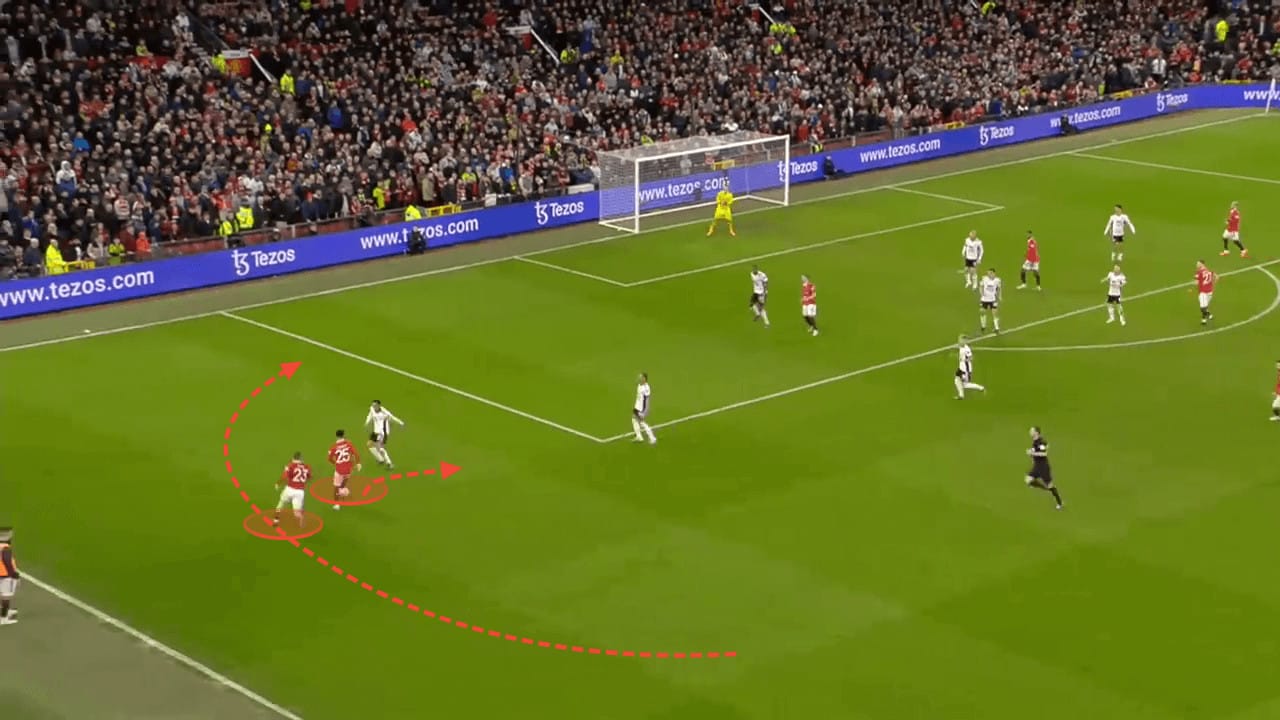
Defensive Phase
Manchester United had a league-high 17 clean sheets last season, with a solid defensive unit being why they also managed to make it to the final of the FA Cup. However, with many strong performances, Man United also succumbed to several high-scoring defeats, including a 7-0 loss to Liverpool and a 6-3 defeat to Manchester City, resulting from a poorly orchestrated press.
On the instances when Erik ten Hag decided to use a mid-block, his side was able to minimise the space opponents had to play in, as well as being aggressive and timing their jumps to intercept and tackle well. The image below shows their 4-1-4-1 block, where the central midfielders can cut off the passing lanes to players in pockets between the midfield and defence. Casemiro has the awareness to pick up free players who move into those areas, so if the ball bypasses the midfield line, he can instantly intercept the pass or close down the receiver. With Onana’s introduction, Man United will look to increase their defensive line height to further reduce the space between the lines, with Onana providing the security behind the defensive line with his aggressive sweeping.
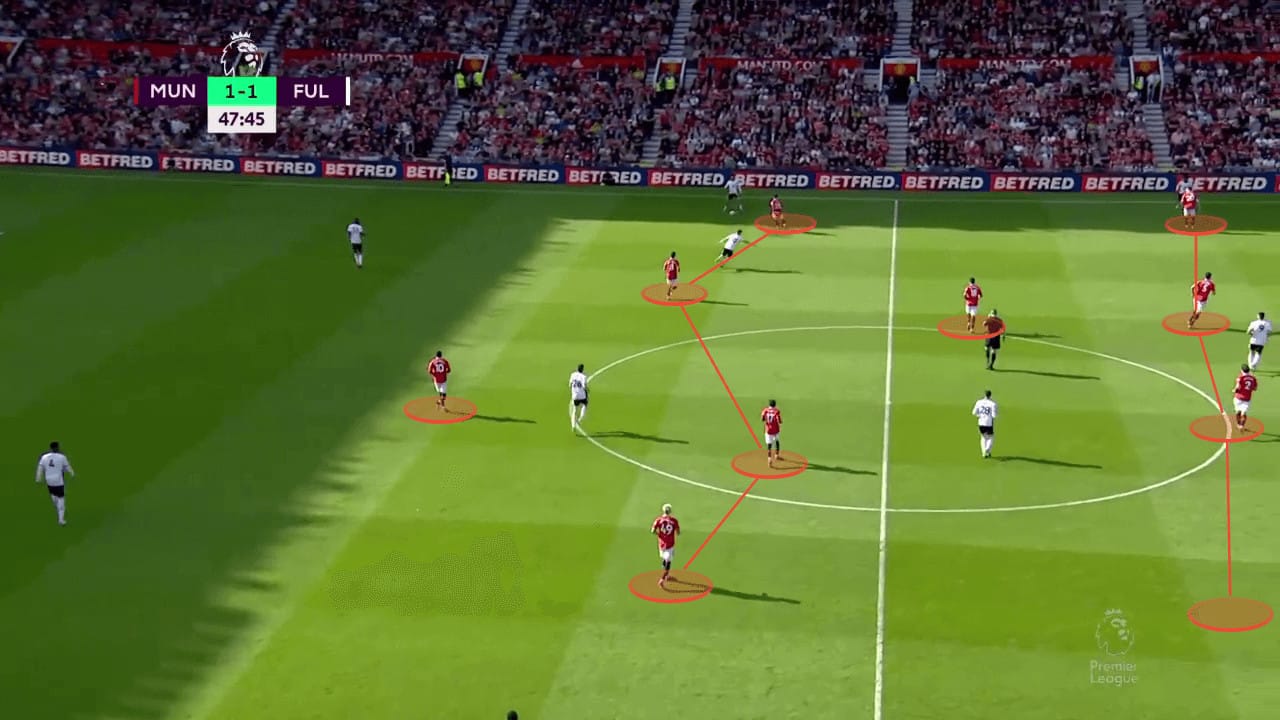
When Manchester United looks to press the ball, they can be aggressive in their movements but often fail to cover every possible option. In the example below, United can force play to one side, then man-mark every viable passing option on that side.
However, the issues arise when an attacker drops into a deeper central area and can pick up the ball unopposed. If the player on the ball in this example is quick enough to turn on the ball and face forward, they could simply play the ball into the open area in the middle of the pitch, where the spare player can drive with the ball without anyone tracking him.
This flaw in their press, where the block is stretched out too far wide, has been the primary reason behind United’s thrashings and will continue to hamper them unless they either fix their movements or decide to sit deeper rather than press the ball.
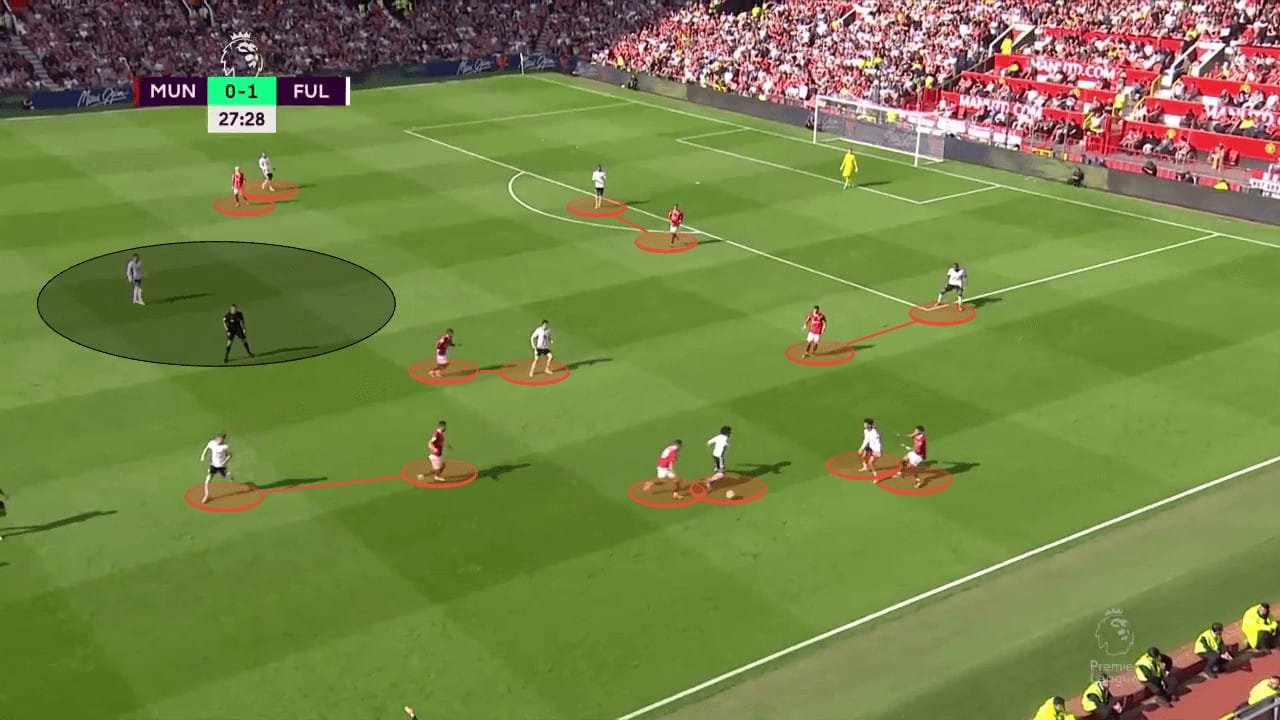
Transitions Phase
As stated earlier, Erik ten Hag plans to make Manchester United the best transition team in the world. The sheer pace of Marcus Rashford, as well Hojlunds speed and physical presence, along with the passing range the likes of Bruno Fernandes, Mason Mount, and Casemiro possess, gives Manchester United firm foundations for an unstoppable counterattacking side.
In the image below, we can see Rashford on the left utilising his speed and ball-carrying ability to drive United up the pitch whilst the other members of the front three join the attack, with Bruno positioned deeper to receive a pass and make the through ball.
The pace and passing ability in the front four already have provided clear evidence for being extremely efficient and hard to stop, whilst the long-range passing ability from deep with Mount, Casemiro, Shaw and now Onana has made Manchester United even harder to stop on the break.
The signing of Hojlund, will give the United attack an option to play longer balls to feet, who can then hold the ball up for his teammates, providing United with a complete set of tools for counterattacks.
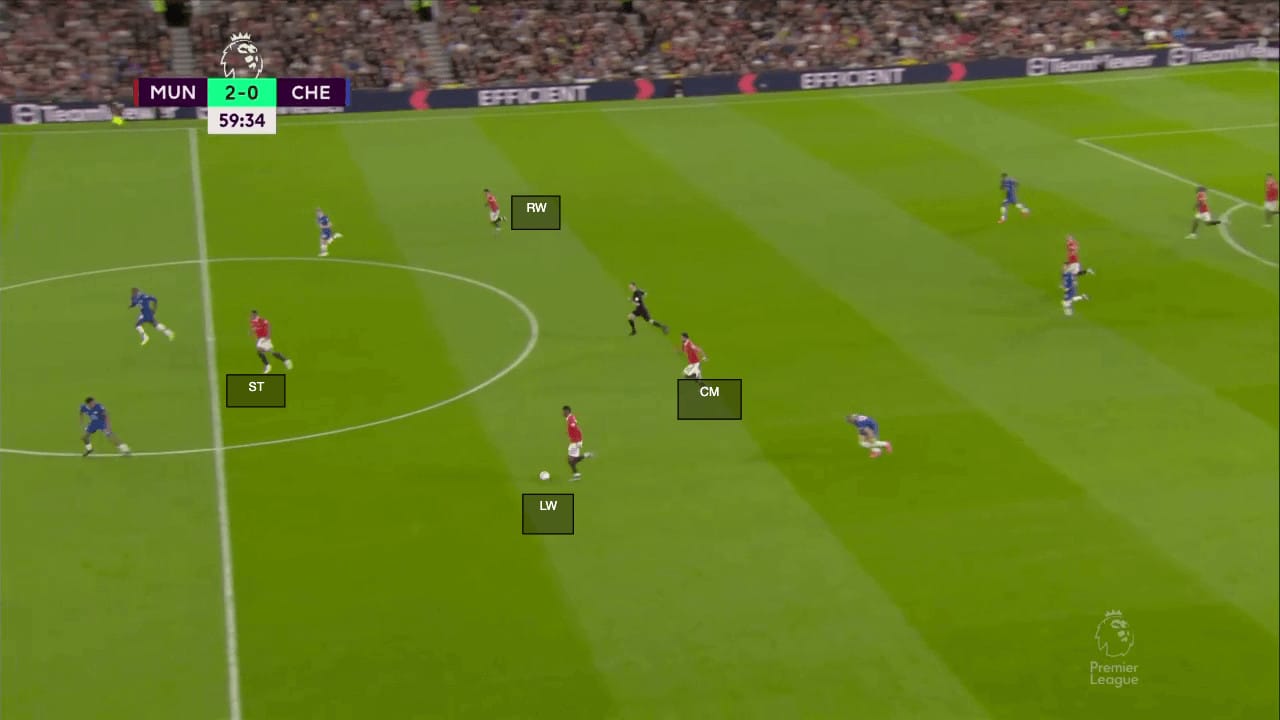
Manchester United have the fundamental understanding during counterattacks to consistently provide problems for opposition defences. The ball carrier drives with the ball into central areas of the pitch whilst teammates spread out to offer passing options.
Keeping the ball central gives attackers added options, as they can make incisive passes to both left and right sides of the pitch whilst also having the possibility to shoot on goal. Fernandes can be seen attacking the left side of the pitch to drag Chelsea’s back-three across the width of the pitch, which gives their defenders extra problems.
Pressure must be applied to the ball eventually to prevent Rashford from unleashing a shot on goal from close range, and that pressing movement is the trigger to pass the ball to the attacker, who is ditched by his marker.
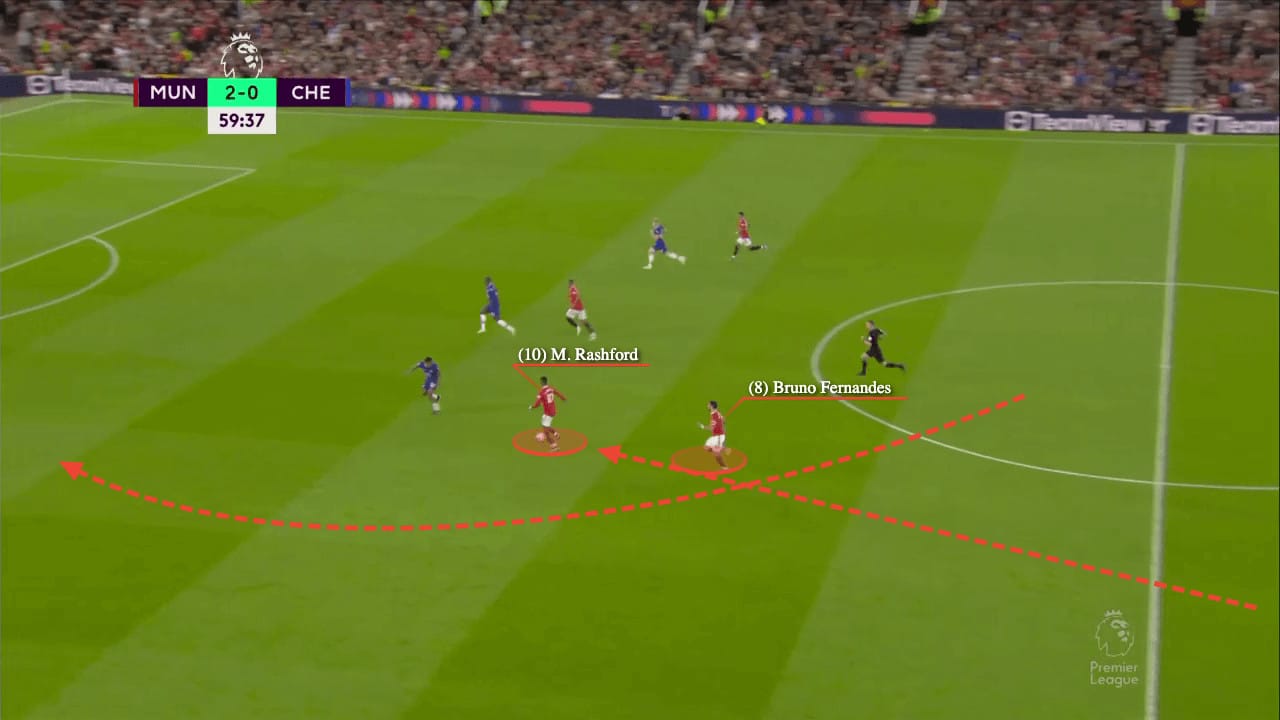
One potential issue which Manchester United will face this season, due to their dynamic attacking plans in the opponent’s half, is that midfielders position themselves too high and vacate the spaces in front of the defensive line.
Casemiro has been known to float inside the box to help attack the box, while Mason Mount also naturally aims to get into the box when his team is on the attack.
The issue with the aggressive double-pivot is that no one in the team then looks to protect the space between the box and the halfway line, where an opposition attacker may be waiting to collect the ball and run at the defensive line.
Even when one player holds their position, the pitch and space left are too big for one individual to cover the area alone adequately. This will leave Man United prone to conceding goals from counterattacks, where they over-commit in attack and don’t have the numbers to defend these transitions.
Mount and Casemiro naturally float forward in such situations, as seen below, although this is Fred and Casemiro, and when the 50/50 is lost, they are not in a position to cut off the passing lanes to the attack.
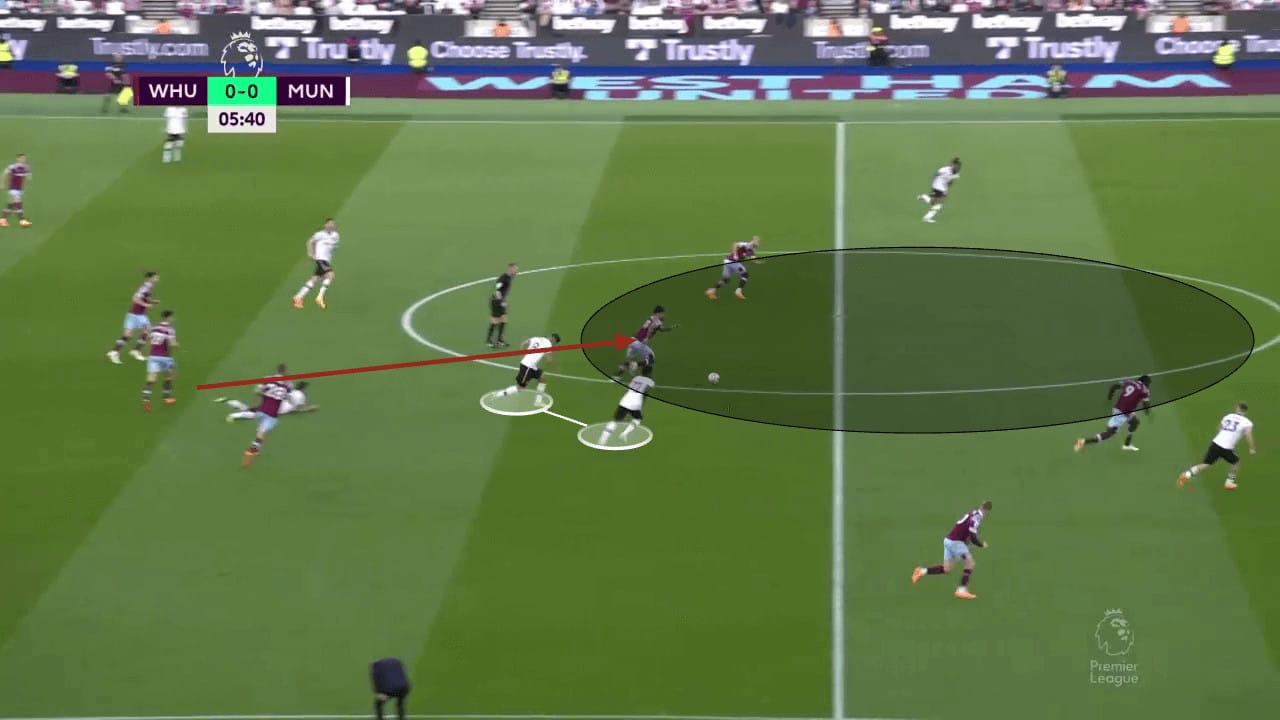
How Erik ten Hag could use Mason Mount
Mason Mount’s move from rivals Chelsea certainly raised a few eyebrows. The Cobham graduate was a two-time player of the year for his old side, including during the campaign in which he was part of a UEFA Champions League triumph.
Mount’s move to the red side of Manchester certainly comes with some question marks, as his play style can be seen similarly to that of Bruno Fernandes. Both attacking midfielders have a great variety of passes in their locker, with numerous creative ways of unlocking an opposition defence.
However, Ten Hag’s 4-2-3-1 system only has room for one attacking midfielder. As a result, Mason Mount is likely to drop into a deeper role, one which he hasn’t featured often in recent history.
From both a physical and technical perspective, Mason Mount has all the tools required to succeed in such a position. Mount can play under pressure, spot passes in small gaps, and the variety and weight of passes to create a dangerous chance from anywhere on the pitch. Mount also has the energy to move from box to box whilst maintaining aggression and intensity in his tackles.
Mason Mount’s ball-striking ability will also give this United side danger from all parts of the pitch. A midfield of Mount, Fernandes, and Casemiro will pose opposition teams with a threat from range because all three players can score goals from range.
Furthermore, Bruno and Mount will aim to create chances for teammates consistently. Mount’s threaded passes from deep and Bruno’s similar ability but in higher areas will mean that Man United will always be one pass away from being in through on goal, no matter where the ball is on the pitch. This United team excels at making incisive passes into the space behind the opposition defence, which is something we can often expect with Rashford’s speed and a new striker’s arrival.
That same energy and intensity in his actions are the same reasons why Mount will provide United’s attacking dynamics with added goal threat during settled possession of the ball.
As seen in the image below, Mount has the desire to commit himself to the box whilst also possessing the know-how of when to ghost into the box and time the movement to arrive with maximal space.
He will often make the late run toward the box when a cross is about to be played in, although this might leave United a little short on defensive numbers in transition.
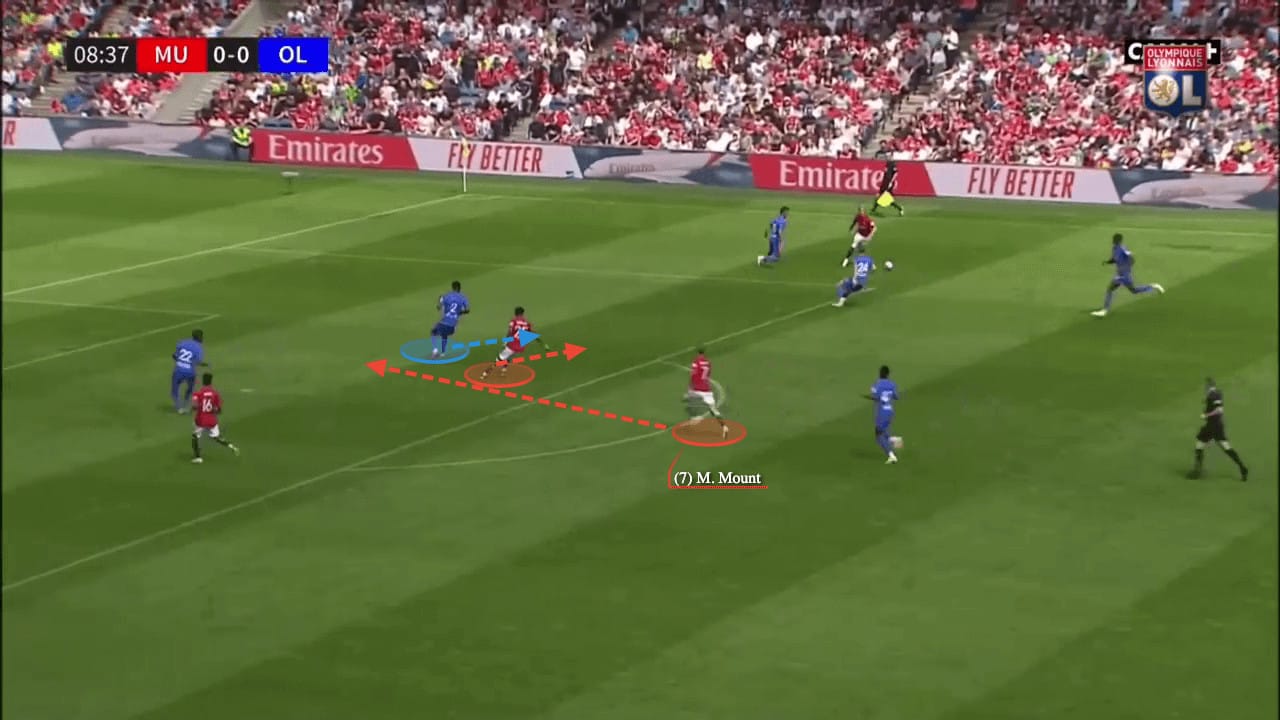
During the build-up phase, Mason Mount’s new role will be to aid the team in maintaining secure possession of the ball and to progress the play into attacking areas. Mount has already displayed a solid ability to switch play to either flank and thread passes into players in pockets.
One slight issue with Mount is his desire to play forward too quickly. In the final third, where Mount has spent the last few seasons playing, taking risks is essential and often necessary to create chances. Attackers have the security of their midfield and defenders behind them to regain possession of the ball should the pass be inaccurate.
However, in this deeper role, Mount has to make sure he picks and chooses his forward passes wisely to avoid attempting unnecessary risks by forcing the ball up the pitch when attackers aren’t in the optimal position to receive the ball.
This example below highlights Mount’s excellent ability to play passes around the corner and his rushed style, where he forces the pass into the front line, where an attacker is marked and unable to retain possession of the ball.
Mount will need to adapt to become more calm in possession, to wait for an opening to appear rather than attempting the pass forward too often.
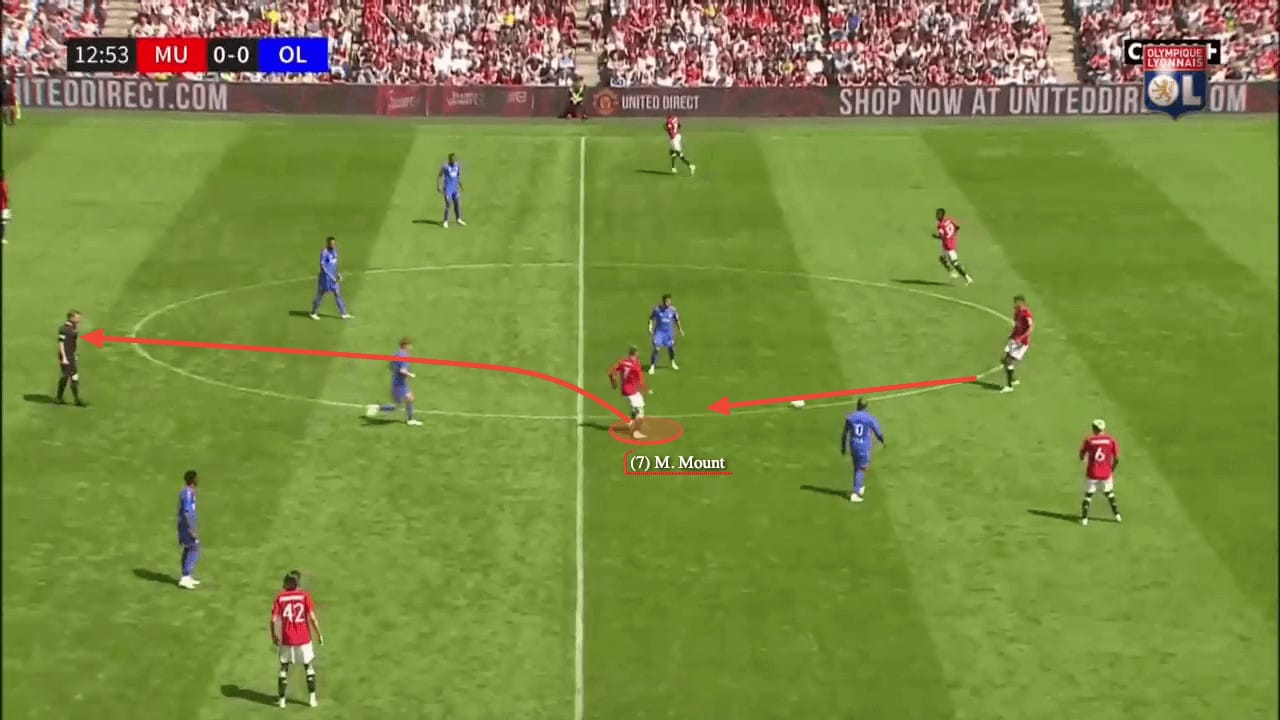
These issues with Mount’s risk-taking capacity could all become irrelevant if his position is pushed higher up the pitch, into the final third, whilst a defender plugs the hole in deeper midfield areas during phases of settled possession.
Key Player
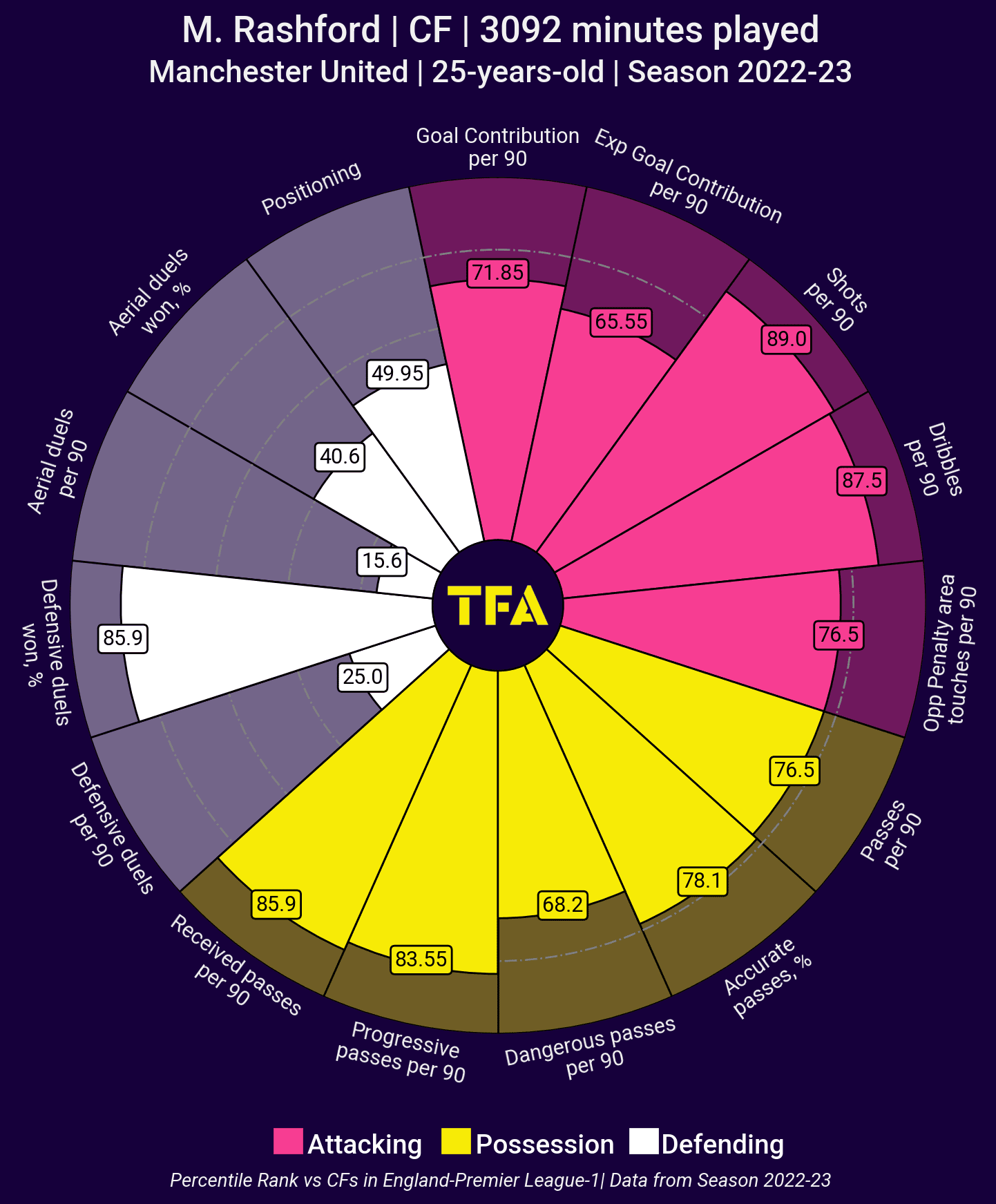
Marcus Rashford will be extremely important to Manchester United’s potential success in the league and cups this season, just like how he has been in recent years. With the striker situation still unclear, Rashford is the only reliable player in the front line who can consistently put the ball in the back of the net. Bruno also provides a threat, although his role is primarily designed to create chances for others.
Rashford has the pace and power to lead counterattacks singlehandedly while possessing the ball striking and composure required to finish these chances consistently. Marcus Rashford has had to rotate between a striker role and on the left wing, but if a striker can be brought in, he will be able to stay in his preferred left-wing position.
A striker who can attract opposition defenders will create additional space for Rashford to attack in behind, who can consistently get onto the end of artillery-like balls from the midfield trio of Bruno, Mount and Casemiro.
In settled attacks, Rashford’s combinations this season with Luke Shaw will also likely be one of the critical methods to United’s attempts to create chances. Rashford’s immediate goal threat from range due to his excellent shooting causes defenders to stay closer to him, which will open up space for Shaw to overlap him into the space behind the full-back, in turn giving Luke Shaw more space to be at his creative best from the wide left position.
One to Watch
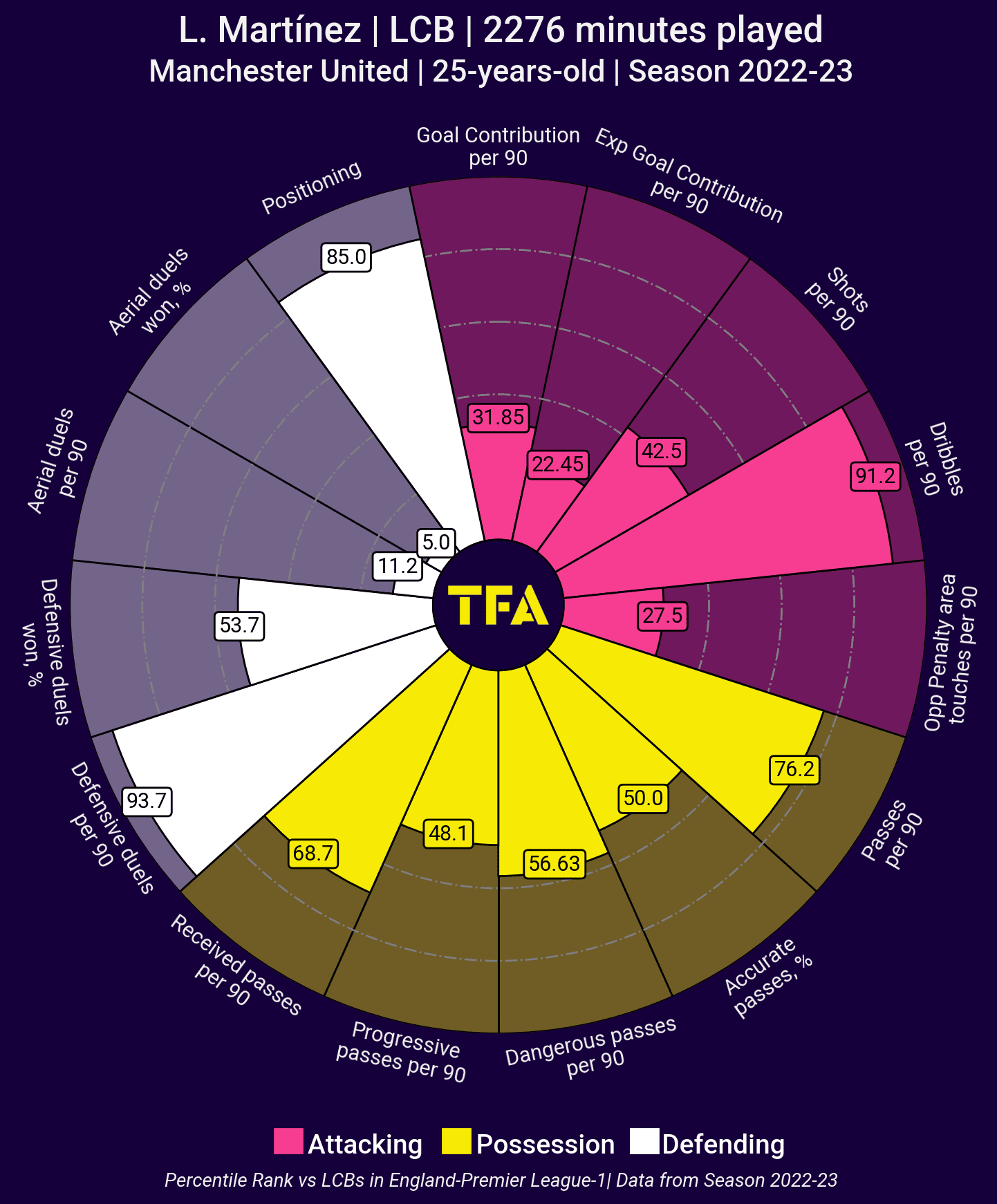
As stated earlier, Manchester United’s attempts to play short from the goalkeeper will enhance Lisandro Martínez’s effect on the team. Martínez is exceptionally agile on the ball for a defender and has the technical ability to receive the ball under pressure and play a range of passes to his teammates.
With United looking to gain more control of matches, Martínez will see more of the ball and gain more opportunities to display his outstanding technical abilities. The Argentinian defender will consistently receive the ball in central areas under pressure, where he can manipulate opponents to create passing lanes to his desired target. He can also evade pressure by carrying the ball up the pitch if opponents press him.
His technical security will enable him to lead the build-up by acting as a reference point, where the ball can be played to him to regain composure for the team under opposition pressure. Martínez’s ball-playing ability will enable Manchester United to dominate games with possession, and he looks to have been given the freedom to drive up the pitch with the ball when the space is present to play incisive passes into the attacking half.
TFA Verdict: 4th
ETH continues to mould the United squad in his vision – moves for Onana, Hojlund and Mount have not come cheap at all. Hojlund is being tipped as United’s Haaland – but do not forget that Haaland arrived in Manchester cheaper and with a goalscoring record for a bigger club than Atlanta that was simply frightening. Onana will be better with his feet than DDG, but with his hands? Wait and see – 4th will match last season but will it feel like progress? Not if Liverpool go past them.

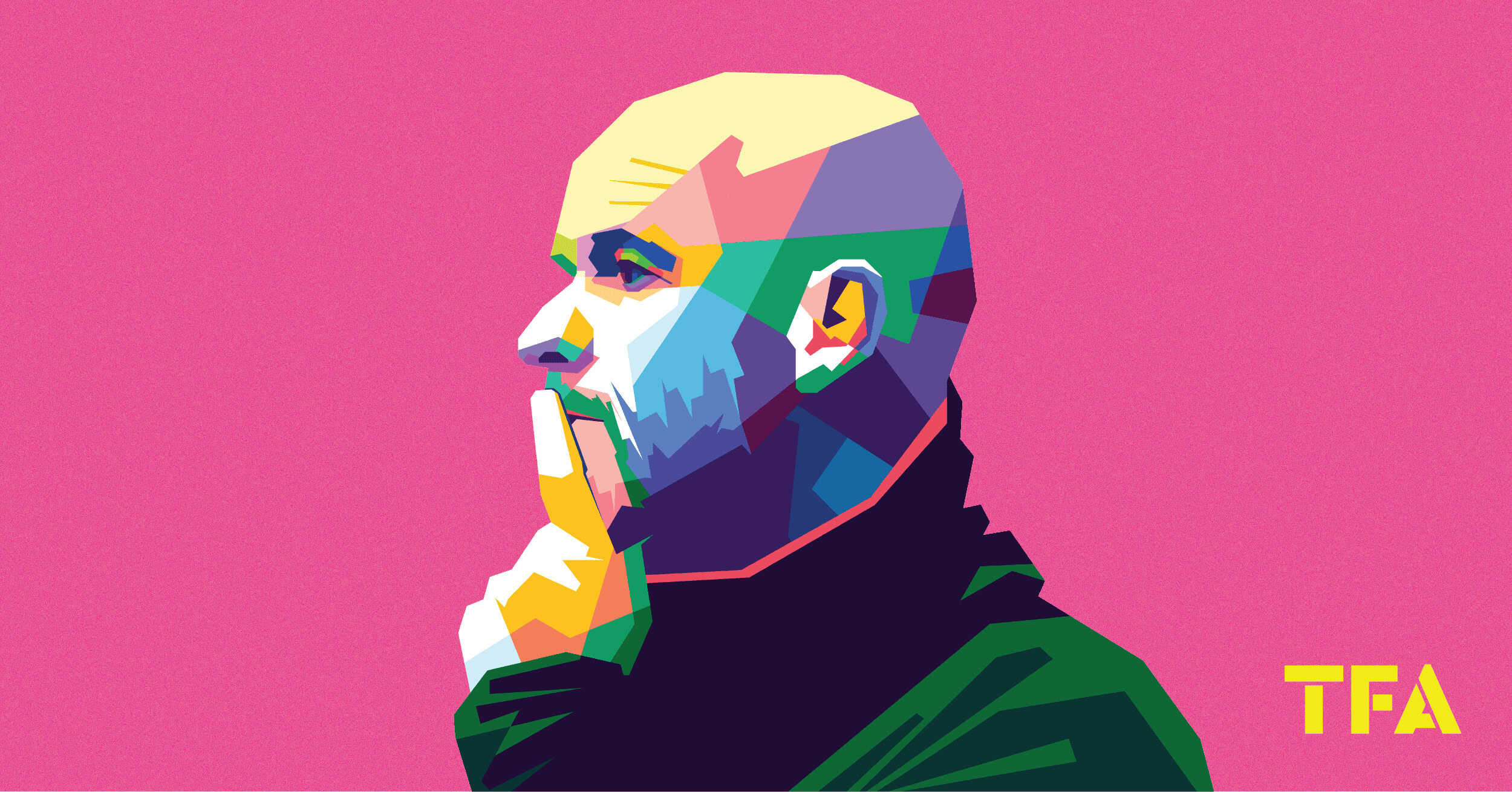




Comments